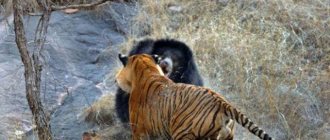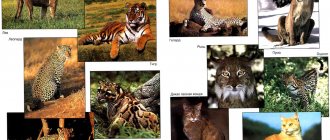There are nine subspecies of tigers in the world. These are the Malayan, Amur, Bengal, Sumatran, South China and Indochinese tigers.
flickr/ianmichaelthomas
While these six subspecies can still be found today, the remaining three subspecies, such as the Caspian, Bali and Javan tigers, were exterminated by humans or became extinct due to the destruction of their habitat.
Amur or Ussuri tiger
flickr/Tambako the Jaguar
The largest subspecies of predatory cats. The length of an adult male Ussuri tiger (lat. Panthera tigris altaica) can reach 280 cm, and weight – 320 kg. Moreover, the length of the tail alone is approximately one meter. It is not surprising that these tigers have a great need for food and are capable of eating up to 25 kg at a time. meat. Thus, in order for the Amur tiger to always be full of strength, it must consume at least 9 kg per day. meat. However, it is known that in the absence of prey, a tiger can survive on a starvation diet for a week.
Predator diet
Since all subspecies of tigers are carnivorous mammals, their diet consists exclusively of food items of animal origin. The only thing is that the diet of such animals depends on the characteristics of their habitat, as well as the availability of food supply. If we take the Bengal tiger's diet as an example, the main source of food is wild boars, Indian sambars, nilgais and axis. As for Sumatran tigers, their main prey are wild boars, tapirs and sambar deer. The diet of Amur tigers includes: musk deer, sika and red deer, including roe deer and wild boar.
The diet of tigers can include Indian buffaloes, as well as elk, pheasants, hares, monkeys, and in some cases fish. In hungry years, these predators eat frogs, various rodents and other small animals, including berries and the fruits of some wild plants. It is also known that adult individuals, if such an opportunity arises, can easily attack other predators, such as leopards, crocodiles, wolves, boa constrictors, including bears that live within a certain biotope.
Seasoned males, who are distinguished by their incredible size and strength, enter into a duel with bears. Despite this, such fights are always unpredictable, since bears are also quite powerful predators. According to some reports, tigers often attack Indian elephant cubs. Therefore, zoos are very attentive to the process of shaping the diet of tigers. Here it is important to adhere to the recommendations of specialists from the Euro-Asian Regional Association.
In any case, it is necessary to take into account the age of this animal, its weight, gender, as well as the season. In addition, it is necessary to pay attention to the fact that the tiger’s diet is varied, including chicken and beef. In addition, the diet should be diversified by including milk, eggs, fish, and other food items with sufficient protein capacity.
In order for a predator to be satisfied and not feel hungry, it must eat about 10 kg of meat per day. At the same time, the consumption rate may vary depending on age, which is associated with its size. As for other products, they are given to the predator in limited quantities to maintain the balance of useful components. When a tiger is in captivity, the diet should include vitamin supplements and healthy supplements containing useful minerals that can prevent the development of rickets in the animal.
TIGER IN ACTION! Tiger against bear, crocodile, elephant, wild boar...
Bengal tiger
flickr/dw_fixit
This predatory cat, as the name suggests, the Bengal tiger (lat. Panthera tigris tigris or Panthera tigris bengalensis) lives in India. However, sometimes it can be found in neighboring countries. This subspecies numbers approximately 1,200 individuals, the size of which is not much smaller than the size of the Siberian tiger - 3 meters long and 260 kg. weight.
Chinese
The name of the species itself speaks about its origin. Not so long ago, these animals inhabited most of China, but now they are on the verge of extinction. There are only 20 rare cats left.
The Chinese tiger is the fastest living species. Unlike his Sumatran younger brother, when hunting he does not strive to drive his prey to the point of impotence. The tiger, if possible, tries to kill its target on the spot by biting the back of the neck.
It reaches a maximum length of 2 meters 600 cm, less than the first debutant on the list, but weighs much more, up to 177 kg.
From 1964 to 2007, the Chinese wild cat was considered extinct. The individual was accidentally noticed by one of the residents of the rural area and showed the photo to the authorities. From this moment on, the protection of the miraculously surviving Chinese tiger is taken with great seriousness.
The roar of a tiger is the same as fingerprints for a person. Common characteristics distinguish the species from each other, and low, varied notes emphasize the individuality of each individual individual. The largest tiger, oddly enough, is the most silent, and the smallest and most aggressive, on the contrary, loves to roar.
Indochinese tiger or Corbet's tiger
flickr/m3nt4t
Distributed in the southernmost regions of China, Cambodia, Laos, Thailand and Vietnam. There are approximately 900 individuals of this subspecies. The population of these tigers (lat. Panthera tigris corbetti) has been poorly studied, since tigers usually live in the inaccessible forests of Indochina.
Where does he live?
The tiger is an Asian animal. Its historical range included the Russian Far East, Iran, Afghanistan, China, India and the countries of Southeast Asia.
Where does the tiger live on the map
Today, in most of these territories, the tiger has been exterminated; large populations remain only in India and Indochina and the Far East (Bangladesh, Bhutan, Vietnam, India, Indonesia, Iran, Cambodia, China, Laos, Malaysia, Myanmar, Nepal, Pakistan , Russia, Thailand).
Tigers live in a wide variety of landscapes: in tropical rainforests, mangrove swamps and bamboo thickets in the tropics, in dry savannas, semi-deserts, bare rocky hills and taiga in the north. In the mountains they are found at altitudes up to 3000 m above sea level.
Sumatran tiger
flickr/paul m. floyd
The life of this subspecies takes place in Sumatra. About 400 individuals are found in the wild, the remaining 235 languish in zoos. With the development of agriculture, the number of individuals began to decrease noticeably, and therefore a program was launched to organize national parks. The Sumatran tiger (lat. Panthera tigris sumatrae) is much smaller than other subspecies. So, an adult male weighs a maximum of 140 kg.
“An incredibly huge beast, just a monster”
For the first time, attention was paid to the giant tiger in Anyui National Park in 2022. In an interview with the Khabarovsk Territory Today news agency, Alexey Gotvansky described the beast this way: “This tiger is a real monster. He's so huge. He was first noticed by his paw prints. Usually males have heels up to 12 centimeters, but this one has 13.5. Then he got caught in a camera trap. An incredibly huge beast, just a monster. It’s good that I managed to meet him not live, but through a camera. There is a shot where this male is looking directly at the camera trap. It’s a pity that only half of his huge muzzle was caught in the lens.”
According to scientists, the Beast was distinguished by a ferocious disposition, which, apparently, made him attractive in the eyes of the tigresses. He paired up with a female, who, of course, received the nickname Beauty.
In 2022, the Monster had already disappeared for some time from the field of view of specialists, and the grown-up sons of the tiger even managed to occupy its territory. However, then the father returned and kicked the offspring out of his hunting grounds.
Habitat territory. Where does the Amur tiger live? Read more
Caspian or Turanian tiger
The Caspian tiger (lat. Panthera tigris virgata) could previously be found in Central Asia and throughout the territory up to the Caucasus. The coat color of this subspecies was bright red, and the stripes were longer with a brownish tint. With the onset of cold weather, the fur became fluffy and thick, and lush sideburns also grew. Exterminated in the 1970s.
Description of the Central Asian leopard
Central Asian leopards today are among the largest subspecies of leopards on our planet. The average body length of a predator can vary between 126-171 cm, but some representatives of the subspecies reach sizes of 180-183 cm, with a tail length of 94-116 cm. The largest recorded length of the skull of an adult male does not exceed a quarter of a meter, and females - within 20. 0-21.8 cm. The average length of the upper dentition of a male is 68-75 mm, and that of a female is 64-67 mm.
The maximum height of the predator at the withers reaches 76 cm, with a mass of no more than 68-70 kg. In the Soviet Union, the leopard is known as the "Caucasian" or "Nast Asian", with the Latin name Panthera pardus ciscaucasica or Panthera pardus Tulliana. Nevertheless, in many Western countries, a completely different name for a wild animal of prey almost immediately came into use - the “Persian” leopard, with the Latin name Panthera pardus saxicolor.
Appearance
The color of the winter fur of the Central Asian leopard is very light, almost pale, and the main background is a grayish-ocher color. Sometimes there are individuals with light gray fur with a reddish or sandy tint, more developed in the back area. Individual representatives of the subspecies are characterized by a light grayish-whitish main background of the coat, reminiscent of the color of a snow leopard.
The light type of color is common and is distinguished by the presence of a grayish-ocher fur background with a slight reddish tint. In the back area, towards the front, the coat is somewhat darker. A significant part of the spots are solid and quite small, with an average diameter of no more than 20 mm.
All rosette-shaped spots are formed by three to five small spots. The tip of the tail is distinguished by three to four black, almost complete and encircling rings. Near the sacrum, as well as in the middle part of the back, there are a couple of rows of large, 2.5 x 4.0 cm, noticeably elongated spots.
Animals with a dark color type are distinguished by a reddish and darker background fur. The spots on the skin of a predatory mammal are predominantly large, solid type, with a diameter of about 3.0 cm. Such spots are located relatively rarely against the background. The largest spots in the sacral area reach a size of 8.0 x 4.0 cm. A significant number of rosette-shaped spots are formed by complete and well-defined rings. Transverse markings in the tail area cover it almost completely.
Lifestyle, behavior
The natural habitat of the Central Asian leopards is subalpine meadows, deciduous forest zones and dense thickets of bushes. As a rule, such mammalian predators inhabit the same area almost throughout their entire lives and do not migrate from one place to another. Such representatives of the cat family, the Panther genus and the Leopard species are quite capable of making short-term transitions, accompanying their prey.
Most often, Central Asian leopards settle in areas inhabited by ungulates, but try to avoid areas that are too snowy. The peak of maximum vital activity of a relatively large predator occurs mainly in the evening hours and continues until the morning.
If the weather is too cool, the animal may well appear hunting even during the daytime. The main hunting style used by such an animal is stalking prey, but sometimes the Central Asian leopard can chase its prey.
Top articles: Long-nosed kuzimanza or long-nosed kuzimanze
Rivalry or territorial conflicts over females occasionally occur, but in any other situations, predatory animals are able to greet each other quite gently. At the same time, the movements of the Central Asian leopards become very neat, extremely clear and do not allow discrepancies, which is due to the natural strength, power, as well as the large size of the representative of the cat family. In the process of greeting, such animals sniff each other’s cheeks and nose, rub their muzzle, sides or heads. Sometimes there are some characteristic playful movements that accompany a positive attitude.
How long do Caucasian leopards live?
The average, scientifically proven to date life expectancy of representatives of the subspecies of the Central Asian leopard in natural conditions does not exceed fifteen years, and the recorded record when kept in captivity is only 24 years.
Sexual dimorphism
The males of the Central Asian leopard differ from the females of this subspecies in the more serious development of muscle mass, large body size and a rather massive skull.
Bali tiger
Lived on the island of Bali and is completely extinct. The smallest in weight and size than other predatory cats. The body of this subspecies (lat. Panthera tigris balica) was covered with short, bright orange fur with black stripes, the number of which was much less than that of other subspecies. Exterminated in the 1940s.
Javanese, up to 130 kg (extinct)
This subspecies once lived on the island of Java, but to date there are no representatives left. Presumably they died in the 80s of the 20th century. But they have been on the brink since the 1950s, when their number did not exceed 25 pieces.
The Javan tiger was last seen in 1979, and there are speculations that there are still animals left somewhere on the island, but this has not been confirmed. They were seen in that part of the island that is covered with virgin forest. But it could also be leopards.
Males of this species weighed from 100 to 141 kg, their body length was about 245 cm. The weight of females was even less, from 75 to 115 kg.
Color mutations
Tigers are characterized by a mutation in coat color. It is for this reason that tigers are often born with white fur, which, however, does not mean that they are albinos. After all, their fur, although white, is covered with black stripes, and their eye color is blue or amber, which is typical for tigers with a normal color.
flickr/sypix
In addition, their non-albino status can be judged by the presence of melanin, the amount of which is not large, but is still present, which cannot be said about albinos. The birth of white tigers at one time or another can occur in each subspecies. But if one of the parents was of the Amur subspecies, then the baby has a better chance of being born white. In addition to white tigers, tigers with an even more exotic golden color are also found in nature. The coat of this subspecies is light with brown stripes.
flickr/Tambako the Jaguar
The white areas of the fur are larger in size than those of tigers of other subspecies. The golden tiger is common not only among purebred Bengal tigers; it can often be found among those in whose veins the blood of the Amur subspecies flows.
Reproduction and offspring
Tigers, regardless of subspecies, are considered polygamous mammals. Their mating season begins in December and can last a month or even more. Males, in order to determine the readiness of females for fertilization, are guided by the special smell of urine, which females use to mark their territory. Each year, the female has only a few days to mate with the male. If for some reason the female fails to become pregnant, then the next female estrus will only appear in a month.
Interesting to know! Despite the fact that the cubs are born quite developed, they are absolutely helpless and are entirely dependent on their mother, who feeds them with her milk.
Representatives of the female population are ready to reproduce at the age of 3 or 4 years, and they have offspring no more often than once every 2 or 3 years of life. The female carries her offspring for 3 months. Males, after they fertilize a female, begin to look for another female, so all concerns about the future offspring fall on the shoulders of the mother. Tiger cubs are born either in March or April. Their number may vary, but generally no more than 4 cubs are born. There are cases when one or 5 cubs are born.
The female protects her offspring as best she can, especially from alien males, since they are capable of destroying them. After 2 months, the juveniles try, albeit not for long, to leave their mother’s den. Only by the 2nd or 3rd year of their life are they capable of independent action: they leave their mother’s den to find and mark their territory.
Facts 16-20
16. The tiger's penis does not stand straight when it is aroused, it is covered with bone and special teeth that help it remain connected to its partner during copulation.
17. Tigers prefer to hunt large prey from ambush. If you look a tiger in the eyes, it is unlikely to attack, as the element of surprise will be lost. In India, many people traditionally wear masks on the back of their heads while walking in the forest to prevent attacks from behind.
18. Tigers do not usually view humans as prey, but will attack if they are threatened. In most cases, a tiger will deliberately attack a person only when there is no other prey available or when habitat is lost.
19. A small number of tigers developed a taste for human flesh and became man-eaters. One tigress, having once protected her cubs from humans, began to feed exclusively on people. She is believed to be responsible for the deaths of 430 people.
20. Thanks to their instinctive characteristics of ambush hunting, even man-eating tigers do not attack entire human settlements; they approach from the outskirts and attack lonely people. They tend to hunt at night, when people are less likely to see him sneaking around.
Pregnancy lasts about three and a half months
It is difficult to identify pregnant tigresses because the bulge does not show until the last 10-12 days of pregnancy. During the last few days of gestation, the tigress searches for a safe place to give birth that will provide good shelter for the newborn cubs and have sufficient food sources.
Each litter can have up to seven cubs, but the average birth is three cubs. Between births there are 18 to 24 months. Tiger cubs are born blind and completely dependent on their mother. They weigh from 785 to 1,610 grams. Tiger cubs' eyes open between six and twelve days. However, they do not have full vision for several more weeks.
The tigress is solely responsible for protecting and caring for her cubs during the first few months of their lives. Tigresses spend almost 70% of their time feeding their cubs during the first few days after their birth. The amount of time spent feeding is reduced to approximately 30% by the time the cubs are one month old.
Lactating females should increase their food intake by about 50% to maintain their milk supply. The tigress stimulates the cub's blood circulation and bowel movements by spending long periods of time licking them. She may also eat the feces of tiger cubs to protect them from potential predators who detect them by smell.
Photo: www.rgo.ru
Tiger cubs begin to eat solid food at 6-8 weeks of age. At four months of age they are the size of a medium-sized dog. Tiger cubs spend the whole day playing, jumping and wrestling with their brothers and sisters. Play helps growing cubs develop useful life skills such as tracking, attacking and climbing. Tiger cubs begin hunting with their mother at the age of eight to ten months. The young become independent at the age of 17-24 months.
Enemies
The tiger is at the top of the food chain in its range, so it has few natural enemies. These include representatives of the canine family, other cats, brown, Himalayan and Malayan bears, and crocodiles. The main reason for hostility between predators is the fight for food. In addition, tigers sometimes deliberately hunt these animals.
Bears are the main enemies of tigers











